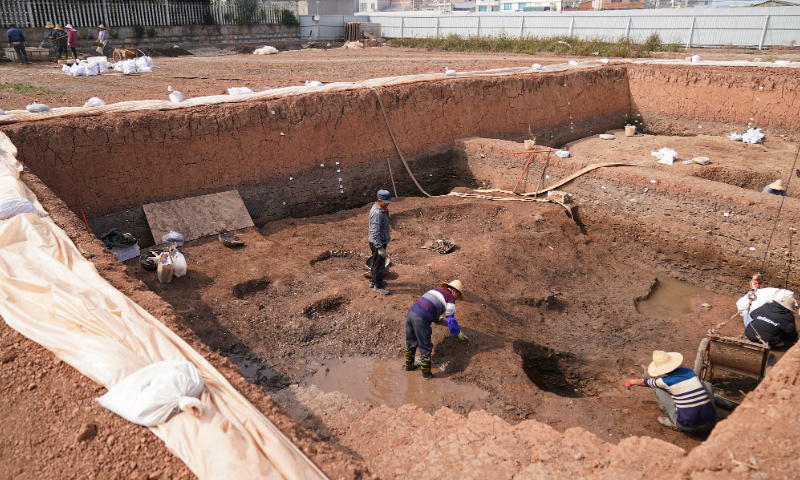SCI-TECH / DISCOVERY
Ancient manuscripts reveal 'Analects of Confucius' spread to Southwest China 2,000 years ago

Excavation site at the Hebosuo site in Yunnan Province on March 3, 2023 Photo: VCG
Recent archaeological excavations at a site in Southwest China's Yunnan Province have uncovered bamboo and wooden slips (known as jiandu in Chinese) with content matching The Analects of Confucius - a collection of ideas and sayings from the ancient Chinese philosopher. This indicates that the Confucian text had spread to China's southwestern region over 2,000 years ago, experts said.
The Hebosuo site in Kunming was once the capital of the ancient Dian Kingdom and later became the administrative center of Yizhou Prefecture during the Han Dynasty (206 BC-AD 220). Prior to the invention and widespread usage of paper, slips of bamboo or wood were tied together to form "books" that could be written upon and rolled up like scrolls.
Experts say these findings demonstrate that The Analects of Confucius reached the southwestern border shortly after the Han Dynasty established the Yizhou Prefecture.
The excavations at the site in 2023 covered an area of 1,000 square meters, revealing building foundations, roads, houses, pottery shards, tombs, and nearly 700 artifacts, including over 300 seal imprints and over 300 bamboo slips with writing.
"The discovery of Han Dynasty bamboo slips at the Hebosuo site is a significant event in the history of bamboo slip discoveries in China," said Chen Wei, an expert at the Center of Bamboo and Silk Manuscripts, Wuhan University.
According to Chen, the content of these bamboo slips is diverse, including official notices, correspondence, judicial documents, household records, and classical texts. These documents provide valuable historical information on administrative divisions, ethnic relations, transportation, and official, tax, and judicial systems.
Chen noted that the records on the bamboo slips reveal how, following the establishment of Yizhou Prefecture, the Han Dynasty systematically extended its administrative, official, household, taxation, and legal systems to the region while also spreading Confucian classics and mainstream ideology. This contributed significantly to the development of the southwest and the establishment and consolidation of a unified multi-ethnic nation.
The excavation also uncovered the bases of six large building pillars, which experts say were likely the foundations of a large official building. These bases, partially exposed and forming an "L" shape covering an area of about 20 meters long and 15 meters wide, were constructed from a mixture of earth and large quantities of snail shells. Construction fragments were also found nearby.
Additionally, a road about 12 meters wide, extending from a road discovered in 2021, was also uncovered. Analysis shows that the road was paved at least three times, with the topmost layer dating to the Wei-Jin period (220-420). This road is thought to have been a main thoroughfare within the city in Yizhou Prefecture.
"We have found important clues in our search for the city wall," said Jiang Zhilong, head of the excavation team at the site. "As we continue to uncover the main roads and large buildings within the site, the layout of Yizhou Prefecture is gradually coming into view."
